Why and How geology and geography play a key role in politics? Or The connections between the European Enlightenment and the Science of Geology and a discourse for the effects of geosciences on the future of the Homo-sapiens (Nationalism versus Internationalism) – The Scottish Enlightenment Part 1: How geology and society have co-evolved from the 18th century till the 2010s

In this section I shall continue the long list of geoscience topics I want to talk about, write about and think about. This section is more concerned with the philosophical meanings of geology and how they impact our thinking about a changing world.
Part 1:
Climate Change and its effects on Political Philosophy and International Relations
How a geological and ecological understanding of the world changes an average person’s perspective on the world. Does our understanding of nature in a scientific manner changes how the average person, the politician and the philosopher see the world? To quote Slavoj Žižek:
“The underlying message of this predominant ecological ideology is a deeply conservative one: any change can only be a change for the worse. So what is wrong here? What is wrong I think is the … principal position … that there is something like “nature,” which we humans, with our hubris, with our will to dominate, disturbed … [W]e know Jacques Lacan’s motto, “The big Other doesn’t exist.” I think we should extend this to nature. The first premise of a truly radical ecology should be, “Nature doesn’t exist.” … So again what we need is ecology without nature, ecology that accepts this open, imbalanced, denaturalized, if you want, character of nature itself. [I]t is … all too easy to attribute our disbelief in the catastrophe to the impregnation of our minds by scientific ideology. [The] standard thesis of the predominant ecology … says something like this: “The ultimate cause of our ecological problems is modern technology, Cartesian subjectivity, within which we are abstract beings somehow outside nature, who can manipulate nature, dominate nature … what we should rediscover is that nature is not out there, an object of our manipulation. Nature is our very background, we are wired to nature, embedded in nature. You should go out, feel, breathe nature. You should accept that your abstract scientific reification … is just an alienating effect of being embedded in the life world.” I think that far from offering a solution, this kind of refere.”
Slavoj Žižek has a very complicated view on how we see nature. Do we see it as a terrible father? Or a gentle mother? Is nature something good, that we tend to destroy, through our individual agency, or is nature something terrible that is on the verge of ripping civilization into pieces? Does nature even exist?
The Nation State, Climate Change and Political Perspectives
How does the idea of the Nation State influence the fight against climate change and how does it clash with an internationalist view of the world. The presentation takes a look at the founding concepts of the Nation State, discusses the origins of Nationalism, discusses the importance of perspectives when looking at the planet, looks at how maps evolved from ancient Rome till today, the different physical spheres that an Earth scientist sees and the cultural boundaries on the planet. Here I argue that scientists, politicians and the average public see the world differently. When all 3 groups look at a map of the world they see different concepts on its surface. The geologist will start thinking about tectonics, outcrops, continental movement. The politician/economist will see trade routes, a global chess board on which armies move and alliances are made. The average member of the public sees nations, divided by borders influenced by culture. The presentation discusses the disadvantages of nation states when it comes to dealing with Global problems.
Climate Change versus Nation State Politics
What is the connection between George Orwell’s Notes on Nationalism and The Climate Struggle between Nationalism and Internationalism? In this presentation I take a look at how nations react to climate change and whether they care about the individual advantage of their own nation as opposite to the collective good. I take a look at how the modern system of the UN formed from old colonialism, how nationalists and internationalists see climate change differently. The main premise of this part is to highlight how some nationalists see climate change as a good thing as it will put their nation at an advantage over the other.
Natural Climate Change
This section is for the general public, it goes through the basic elements of Earth’s climate system and explains how changes in these, effect long term climate change. This section exists to highlight that natural climate change does occur and put in contrast to human induced climate change.
The BGS has some wonderful resources on explaining how our planet works and what factors regulate the current temperatures of our planet.

The geological history of Britain in a single snapshot
How does Climate Change and Geology affect our Political Discourse?
How do politicians react to climate change and the science of geology when they try to win votes for power? Political systems are not just about getting power but also gaining legitimacy within the population so policy changes are trusted by the population. Geologists are scientists and are respected by the public, but only elected politicians have the legitimacy to carry out changing the laws. I also try to understand how our understanding of the geological world changes our view of the world, if we deconstruct ideas and objects, do we change their meaning? If we find out something’s origin does our relationship with it change? This presentation finishes with a reading of Carl Sagan Pale Blue Dot.

The science is clear: Every half a degree matters
Summary of the whole lecture:
My aim is to get people to think about the deep questions brought up by geology in the context of politics and international relations. I worked both in politics and studied geology. While the two subjects are very different they have overlapping questions and concerns, especially when it comes to climate change. I also find interesting questions between mining and politics. Where would a mine be put and why? How does the product of a mine get from the pits into smelters then into factories, then to the consumer in a form of a finished product?
While I think about these questions, I am also grabbed by something deeper: does geology make us question our very selves? Does it bring up existentialist questions? Did the discovery of geology make us see the world not in the immediate present but helped us see into the far past (deep time), and in turn helped us look into the far future?
This is essentially the question of climate change? How far does our time go? Is it just a day? Is it a few centuries, or is it millions, if not billions of years? I study both human history and natural history. The idea of a “long time ago” is very different to the two subjects. To the people of the modern times, the past is the 1980s, to a historian it is the time of Trajan, him marching into Dacia, to a geologist, when Pangaea existed 200 million years ago. Time is very deep.

James Hutton
The Scottish Enlightenment and Geology
The Key Figure: James Hutton
Where is James Hutton from? Who is he? What were the steps in his life, the people in his life who shaped his life and ideas? How did he shape the world in turn?
In my eyes the key person who represents the Scottish Enlightenment is James Hutton. He is the Great Man of historical theory, who ushered in a new age of thinking. The man who stood up to the church, the man who wondered Scotland, bringing back the knowledge to the masses, the man who touched God himself through time (not that way). Did James Hutton step forward, using the might of his mind to move rocks? To move time itself?
Or
James Hutton was a product of his time. He wasn’t the great man just one of many, part of a network of individuals, building Science in the pubs and tea houses of Edinburgh, Glasgow and Aberdeen. He used the ideas of his fellow thinkers from the same era and the ideas of people who came before him.
Hutton is an interesting character. On one hand he was a scientist with a far sight, the ability to assemble separate parts of information into a workable theory, a person who could see beyond 4004 BC. A person who had enough drive to tour the Scottish Highlands in the 1700s, while in his 60s. On the other hand, he didn’t start out as a geologist or as a philosopher. He started out as a chemist, then moved into medicine, writing about the circulation of blood in the human body, then moved back to his farm in rural Lowland Scotland to become a botanist.
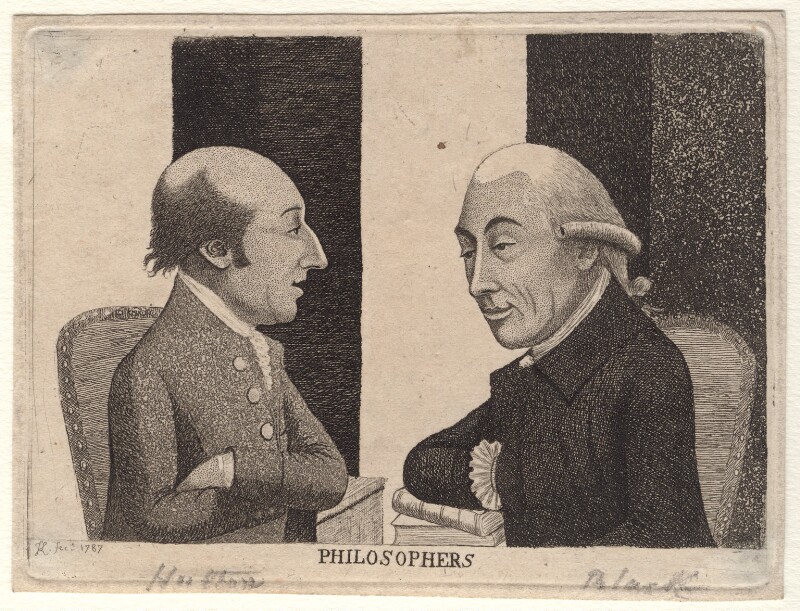
James Hutton and Joseph Black
(I think it is an interesting feature of geology that the science was originally part of the School of Philosophy and later moved into its own field of Earth Sciences. Geology requires a level of imagination that is just beyond the average human mind as the landscapes shift all too fast and the time is in the millions of years. Raw crunching of data in modern universities is a soulless task, which murdered geology, none of the magic is there to understand the landscape, therefore the subject is dying unable to attract outsiders.)
I think it is crucial to return to some of the original ideas of Hutton. Observation of nature, by being at the location and observation of nature running through its own mechanics. I heard of a metaphor where the runnings of nature are compared to the insides of a mechanical clock. Every part, every gear has its role in the complete operation of the clock. Geologists in a certain way can be compared to watchmakers, who peer into the insides of the mechanism and understand how the whole works.

James Watt and James Hutton’s letters
Ideas that shook the world – This campaign promotes the National Library of Scotland’s free exhibition ‘Northern Lights: The Scottish Enlightenment.’ From David Hume to Adam Smith, figures of the Scottish Enlightenment created, discussed and refined ideas that challenged established views and had a profound effect on the society we live in. Their ideas of science, philosophy, language and economics shook the world. David Boni brought the creative idea to life by capturing utterly flabbergasted portraits in the style of the time, across posters, social, and out of home. The free exhibition runs until 18 April 2020 at the National Library of Scotland, George IV Bridge, Edinburgh.
This idea in geology was pioneered by James Hutton through the Scottish Enlightenment.
On a side note:
James Hutton had an interesting private life as well. He was infamous for drinking, traveling, and his relations with women. When he was at university, he got a girl pregnant (he was famous for rampage across the streets of Edinburgh when young) so his family exiled him to the wet countryside where Hutton toiled in the mud of his farm, redeeming himself by coming up with the basic laws of geology. He returned to Edinburgh, back from the wilderness, to share this golden insight with a fine society of Edinburgh, lighting the candle of the mind which shined down to England than through Europe! (Here we go again with the great man theory of history!) (I heard this story from the TV show, Man of Rock by Iain Stewart, so complain at him if you feel that Hutton’s character has been besmirched: https://twitter.com/profiainstewart)
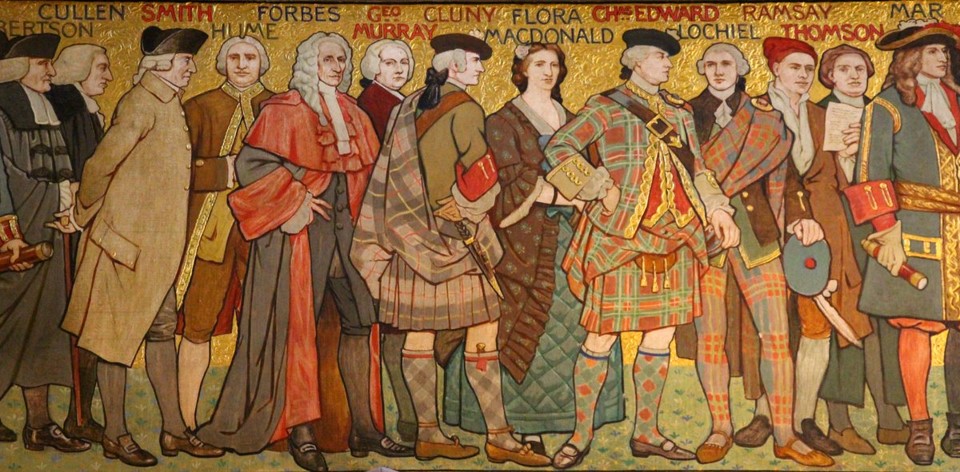
The age of Enlightenment
Well in reality, it is most likely that it took him decades to come up with the basic ideas, with some great ideas punctuated in-between, where he made rapid progress, given to him by his connections with the Literati around Edinburgh and Glasgow, the ideas entering academic papers and speeches that struggled to gain traction within academia let alone the public. His ideas were widely circulated around Europe, however due to Hutton’s difficult writing style they never gained any traction as part of a new science. By the time Hutton died his ideas were still seen as fringe theories in contrast with Neptunism and described as theories and stories rather than trustworthy science.
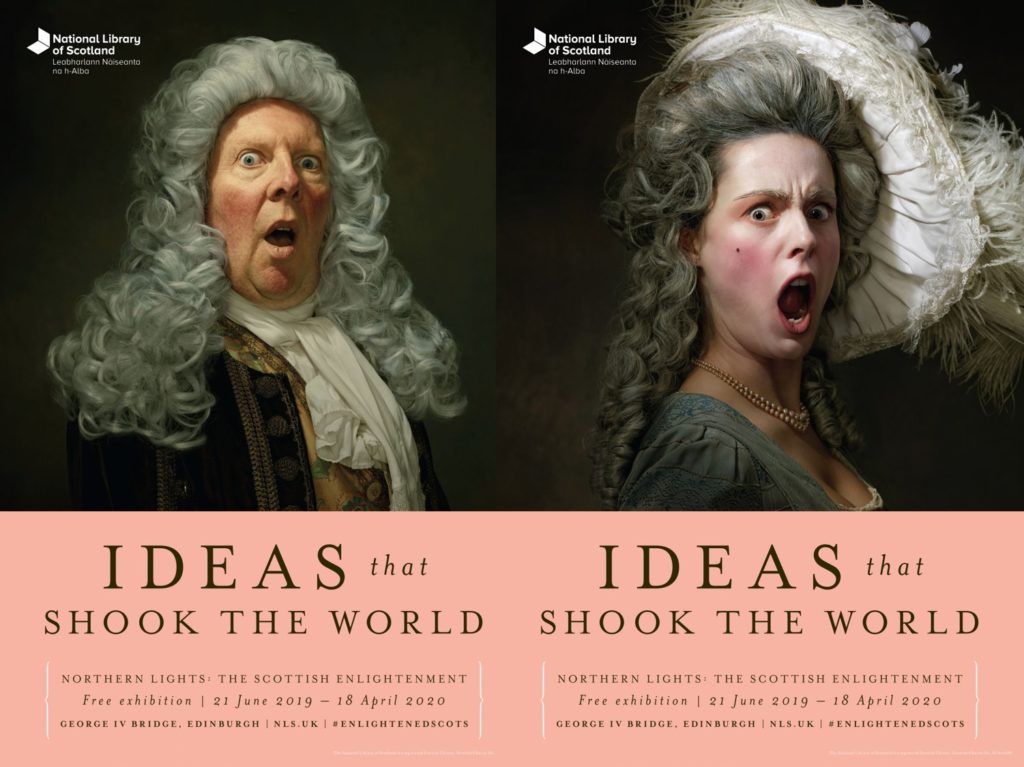
Shocking ideas!
Fortunately for us and fortunately for the Scottish people and the people of Angus, John Playfair, a close friend of Hutton, condensed the ideas of Hutton into a simple book, the Illustrations of the Huttonian Theory of the Earth. It established the main ideas of Plutonism, Uniformitarianism, discussed Earth as a heat engine, Earth’s true ancient age and laid out the key mantra of the present being the key to the past. This was further helped by Charles Lyell who turned Hutton’s vague ideas into a systematic science after traveling Europe and America, proving that geological formations in Scotland had equivalents all around Europe and America, and some of the past formations found in Scotland were still forming in other parts of the world. Charles Lyell introduced the empirical system where natural processed had to be directly linked to formations. In contrast Hutton took some human examples (this is explained in more details bellow) from the machines of James Watt, from the theory of Man of David Hume, to the theory of latent heat of James Black and imagined them to be the facsimiles of the forces of nature.
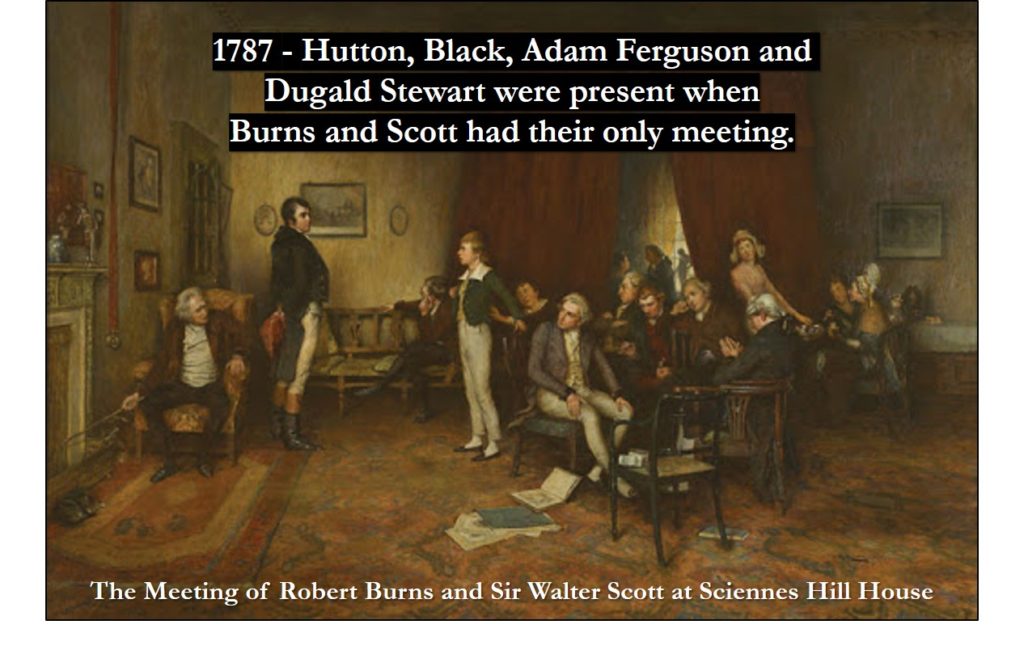
The meeting of geniuses
Hutton was a key figure whose life had ups and downs, while alive he built up a basic science which stood as a direct contrast to the might of the Church (again this gets complicated as the 18th century Scottish Kirk actually accommodated new ideas and built up a Scotland wide school system enabling Scotland to have a high percent literacy rate by 1700 in contrast to the most of Europe, 3 universities in Scotland were set up by the Church while the 4th and last one, Edinburgh, was created by the Town Council, as a radical idea, part of the people’s university movement from Paris), setting up a science that through a domino effect played a role in the discovery of evolution, the oil boom, British Imperialism and the wars the currently rage across the planet for resources.In the chapters bellow I try to have some overview and some insight into how James Hutton developed his theories, how he interacted with other thinkers of his time and how his ideas were carried forward by Adam Sedgwick, Charles Lyell and Charles Darwin.
But one thing is sure. Like we take pride in our victory over (in) Europe over 75 years ago (our nation really needs a different hobby), we should take pride in James Hutton and his achievements.
A basic look through of the connections
“Civilization exists by geological consent, subject to change without notice.” – Will Durant
Geology played a key role in the Scottish Enlightenment and in the European Enlightenment, it acted as an underpinning element of philosophy which developed against the church. The science provided the factual underpinning of opposition against religious orthodoxy. Earth being millions if not billions of years old along with the discovery of evolution removed the idea that the church was infallible and only ancient texts could provide answer to questions about the state of the world. While geology didn’t move the rocks of human ideology on its own, it played a significant part in it from Hutton to the plate tectonics revolution.
The 3 key ideas within foundational geology, ideas cooked up by Hutton and Lyell. The Scottish connection – Not all innovation came from beyond Scotland’s borders, and that which did was just as likely to have come from the Netherlands as from England, especially in the field of medicine. There were powerful links between medicine in Leiden and in Edinburgh. There were also entirely local traditions in mathematics, chemistry and medicine.
The ideas explored by Hutton, Lyell, Sedgwick can be observed at the Siccar Point location in Scotland. Hutton reached the exposure bellow on boat. The location can be observed from above the cliffs as well. As described by Iain Stewart this location can be considered one of the holy sites of geology. The bottom layers are from the Silurian, an ancient sea bed. Due to the mechanics of plate tectonics, the whole bed has been tilted vertically. On top gently sloping, red sandstone lies, deposited in the Devonian. In between, a jagged eroded unconfirmity filled in with breccia stone. The two layers are in a beautiful contrast to each other. The bottom deposited in the depth of a sea, miles bellow the water, while the sandstone was laid down by howling winds in a dry desert. In between a lot of stretching and tilting with finally the erosion of the sea exposing the site.

Siccar Point
When Hutton stared down these rocks, squeezing information out of each layers, he realized that this formation needed lots of time to form. Time that didn’t fit into the Kirk’s view of the Earth, or into the view of the Neptunists. A single site like this managed to upset the Apple cart of ideology in 18th century Scotland. Hutton’s question by accident undermined (like Charles Darwin a 100 years later) man’s basic assumption about the nature of the world. Before Hutton the world made sense, orderly, under God, made on a Tuesday when God got into gardening. It had a start, a middle and an end. Than Hutton burst forward and proclaimed the world to be endless both through space and time. After Hutton the world was this new mysterious place where millions of years and states of nature were trapped in rock. And unlike in the Bible or a Greek text, the answers were hard to find.
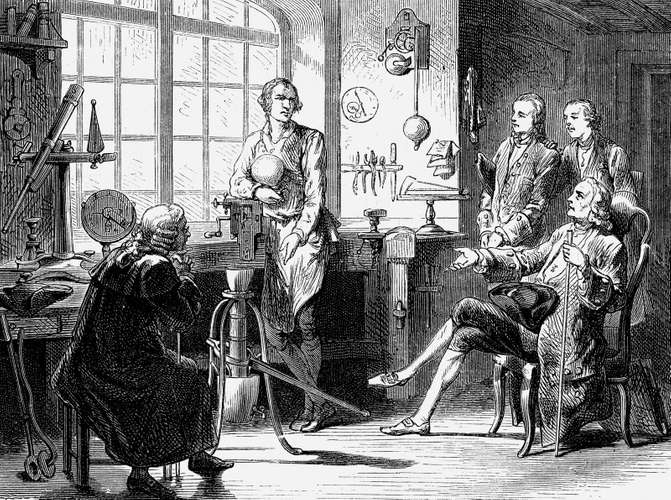
Joseph Black visiting James Watt in his University of Glasgow workshop.
If you want to find the place where the Church lost most of its power over Europe and the world, you can look upon the rocks here. This is the place where the Church’s command over eternity died, while Hutton’s view on eternity was born. The birthplace of a new world.
Percy Bysshe Shelley and Mary Shelley were both familiar with James Hutton and his theory of an endless Earth. By the time of their writings in the early 19th century, Hutton’s ideas were somewhat well known by the upper English circles. Hutton’s ideas played a key role in shaping the Romantic movement of the same period. Hutton’s ideas can be reflected in the poem by Percy Shelley, Ozymandias:
I met a traveller from an antique land,
Who said—“Two vast and trunkless legs of stone
Stand in the desert. . . . Near them, on the sand,
Half sunk a shattered visage lies, whose frown,
And wrinkled lip, and sneer of cold command,
Tell that its sculptor well those passions read
Which yet survive, stamped on these lifeless things,
The hand that mocked them, and the heart that fed;
And on the pedestal, these words appear:
My name is Ozymandias, King of Kings;
Look on my Works, ye Mighty, and despair!
Nothing beside remains. Round the decay
Of that colossal Wreck, boundless and bare
The lone and level sands stretch far away.”
An ordinary stretch of coast giving birth to an extraordinary idea
The rugged point shows gently sloping beds of red sandstone above vertical beds of greywacke, forming a classic example of Hutton’s Unconformity.
I do have a bit of a criticism of this narrative. Once more it relies on the great man theory of history (definition given bellow):
“Universal History, the history of what man has accomplished in this world, is at bottom the History of the Great Men who have worked here. They were the leaders of men, these great ones; the modellers, patterns, and in a wide sense creators, of whatsoever the general mass of men contrived to do or to attain; all things that we see standing accomplished in the world are properly the outer material result, the practical realization and embodiment, of Thoughts that dwelt in the Great Men sent into the world: the soul of the whole world’s history, it may justly be considered, were the history of these.” – Thomas Carlyle in the book: On Heroes, Hero-Worship, and The Heroic in History
Great people and great minds, with great events shape history and the rest of us are pushed around like sheep, following whichever bright flag is waved at us from the top of a tall pole.
I think in geology we tend to make the same mistake as explored above. We concentrate on great sites and great people. But we don’t look at wider social movements and the connections between the scientific ideas, of how small scale researchers and sites lead to a realization of ideas in greater contexts.
The reasoning of James Hutton – Observing Nature away from the texts, played a major role in the scientific revolution of the 18th century, before hand it was expected, for the scientist, to place their field observations within the context of the Bible, or base the whole of their scientific opinion on the Bible. These led to incorrect ideas within geology, where granite was seen as the oldest of rocks (when in reality granite intrusions tend to be young), and the early scientists theorized that all of the rocks emerged from an ancient sea (possibly caused by Noah’s flood).
One of the key defining features of Hutton, was his interest in individual observation. He was against the idea that one should rely on old texts such as the Bible to come up with theories on how the Earth came to be. He advocated for observing the world with our own eyes, visit the sites of interest, and taste nature with our natural senses. James Hutton also advocated for observing present processes such as volcanic eruptions, study the content produced from the process, than compare the material found somewhere else with the fresh product to see, if the far away lands, far away deposits from the process, have similar layouts or made of similar material. This allowed Hutton to explain that the “present is a key to the past”, a concept which is still used in geology today.
Using this principal, Hutton observed, the before described Siccar Point, granitic intrusions in the Highlands and concluded that processes that happened on the sea floor and deep within the subterranean, produced deposits which now were on dry land, on the coast, or on the top of mountains.
Hutton realized, that A. not everything crystallized out of a large sea and B. it took millions of years for these processes to happen. This put him at odds with the Bible and it’s fixed points of creation. First he managed to point out that the world is millions of years old, if not infinitely old and God didn’t create a static world from the beginning, everything is in motion and constantly changing. (This also inspired Charles Darwin down the line who took Hutton’s ideas with him to the Galapagos Islands.) Secondly, he figured out the rock cycle. He understood that underground heat drives the great circulation of material.
“The result, therefore, of our present enquiry is that we find no vestige of a beginning, no prospect of an end.” – JAMES HUTTON (1785)
Hutton managed to open up deep time. His work was really important for scientists such as Charles Lyell, Charles Darwin and Mary Anning to aide their work in geology. Hutton is the founder of the science of geology.
“We know that the land is raised by a power which has for its principle subterraneous heat, but how that land is preserved in its elevated station, is a subject which we have not even the means to form a conjecture.” – James Hutton
Hutton has hundreds of great quotes about the Earth, its nature and how it functioned.
“… in every quarter of the globe, and in every climate of the earth, there is formed, by means of the decay of solid rocks, and by the transportation of those moveable materials, that beautiful system of mountains and valleys, of hills and plains, covered with growing plants, and inhabited by animals.” – James Hutton
Hutton is famous for his work in geological sketching, helped by John Playfair.
“The volcano was not created to scare superstitious minds and plunge them into fits of piety and devotion. It should be seen as the vent of a furnace.” – JAMES HUTTON (1788)
Charles Lyell gives a scientific basis for geology, he set up a method based on change through time. He highlighted that Earth wasn’t fixed, it was in an up and down motion. He based those ideas on Hutton’s work. Charles Lyell traveled all over America and Europe. He made detailed tertiary maps of European sediments, and mapped the eastern side of North America. He visited several volcanic spots in the USA and compared it with European volcanoes. He was meticulous in his work, realizing that all geological process on Earth are universal.
“But Geology carries the day: it is like the pleasure of gambling, speculating, on first arriving, what the rocks may be; I often mentally cry out 3 to 1 Tertiary against primitive; but the latter have hitherto won all the bets.” – Charles Darwin
Adam Sedgwick (22 March 1785 – 27 January 1873) was a British geologist and priest, one of the founders of modern geology. He proposed the Cambrian and Devonian period of the geological timescale.
These are crucial connections between Hutton and his fellow contrarians. 18th century Edinburgh is a brand new city. New Town is being built, the University of Edinburgh has 1000s of students from across Europe. It is the centre of the buzz of the European Enlightenment.
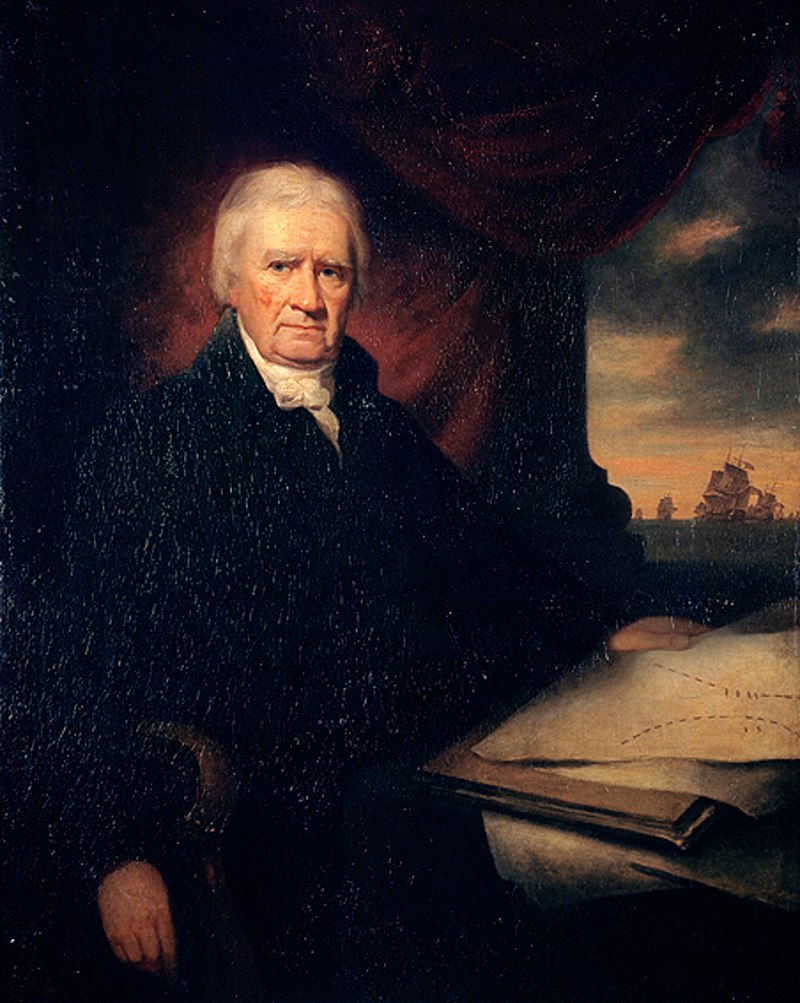
John Playfair
Here Hutton’s genius shines through! He figures out that the heat of the steam can preform work. That heat can be turned into physical work that moves machines. Therefore the machines of Earth beneath the rock has done the same for the land. He has a mechanism (the volcano), which moves the great masses of rock around the surface of the Earth.
” …the mind seemed to grow giddy by looking so far into the abyss of time” – JOHN PLAYFAIR (1748 – 1819)
When James Hutton went out on field work, he was accompanied by a whole plethora of friends and budding geologists.
Angus Greats:
Tayside and the county of Angus has a rich geological heritage. It is transected by the Great Highland Boundary Fault dividing the gently flowing Lowlands from the majestic Highlands. The Lowlands are made of sedimentary successions, dominated by Sandstone from the Devonian period.
However in this section of the presentation I aim to focus on the great geologists who were born in Angus and helped Hutton while he was alive and refined his theories after his death allowing the next generation to study the science of geology.
How mountains moved
Dr Henry Moubray Cadell and the building of Europe
He was a talented geology teacher who working against the BGS managed to discover how the deep faults in the Highlands were the result of mountain building. He build sandboxes with squeezable arms which allowed the compression of sand. This simulated how the crust deformed.
“the earth, the very emblem of solidity, has moved beneath our feet like a thin crust over a fluid” – Charles Darwin (Chile, February 20, 1835)
As it can be seen bellow on the video, the first act of European Union:
The key is Siccar Point – An endless cycle of creation and destruction of rocks.
A great way to represent the ideas explored and explained by Hutton, Charles, Adam is to bake a cake. It might sound like a simple idea, but the different layers of sponge is perfect to represent single layers of rock. You can tilt the first layer, put down frosting, than put down horizontal cake. An entire outcrop replicated in cake.
Part 2:
Part 2 of the Scottish Enlightenment, where I focus on how Hutton used ideas from his time, to incorporate them into his own theories on geology. Here I try to show, that Hutton couldn’t have succeeded without the aide of his friends and how the work of David Hume and James Hutton influenced each other in such a crucial manner. Hutton took the end products of industrial processes just emerging in Scotland and imagined them in the context of nature, such as a volcano being a giant furnace.
This segment was inspired by a BBC Radio 4 broadcast: Early Geology (In Our Time).
https://youtu.be/B9eo_uoCF2U
The reasoning of James Hutton – Observing Nature away from the texts

One of the key defining features of Hutton, was his interest in individual observation. He was against the idea that one should rely on old texts such as the Bible to come up with theories on how the Earth came to be. He advocated for observing the world in the the present as it is, not as described in old texts. He got this idea from David Hume who also made the same argument about the Bible and our understanding of the world. According to Hume we need to observe the world on our own rather than rely on other’ people’s descriptions.
This encouraged Hutton to study the geology of the area through his own trips and studies. Along with James Watt, this made James Hutton combine laboratory experiments with field observations!
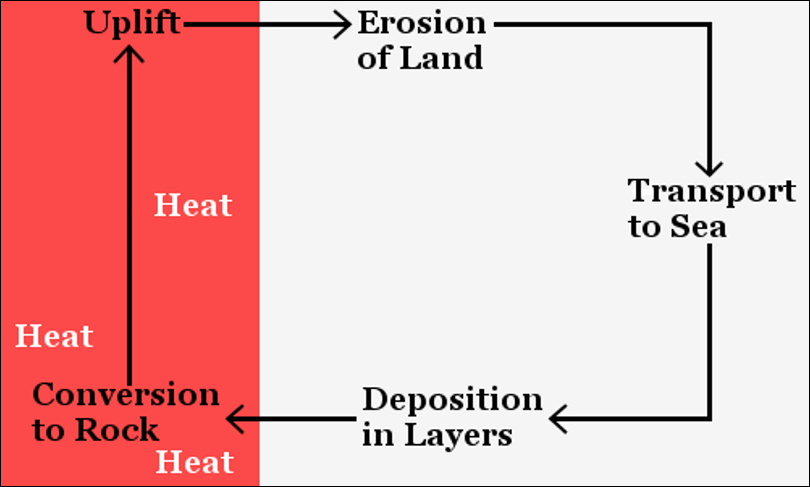
Hutton was the first man to understand the concept of the rock cycle. He stipulated that Earth is a heat engine, with a thin rocky crust at the top. Rocks are created through a cycle which is eternally rotating molten rock to the surface and pushing cold rock back into the heat engine. Hutton liked to compare the Earth’s processes to the steam engine machines of James Watt.
“We know that the land is raised by a power which has for its principle subterraneous heat, but how that land is preserved in its elevated station, is a subject which we have not even the means to form a conjecture.” – James Hutton

“… in every quarter of the globe, and in every climate of the earth, there is formed, by means of the decay of solid rocks, and by the transportation of those moveable materials, that beautiful system of mountains and valleys, of hills and plains, covered with growing plants, and inhabited by animals.” – James Hutton
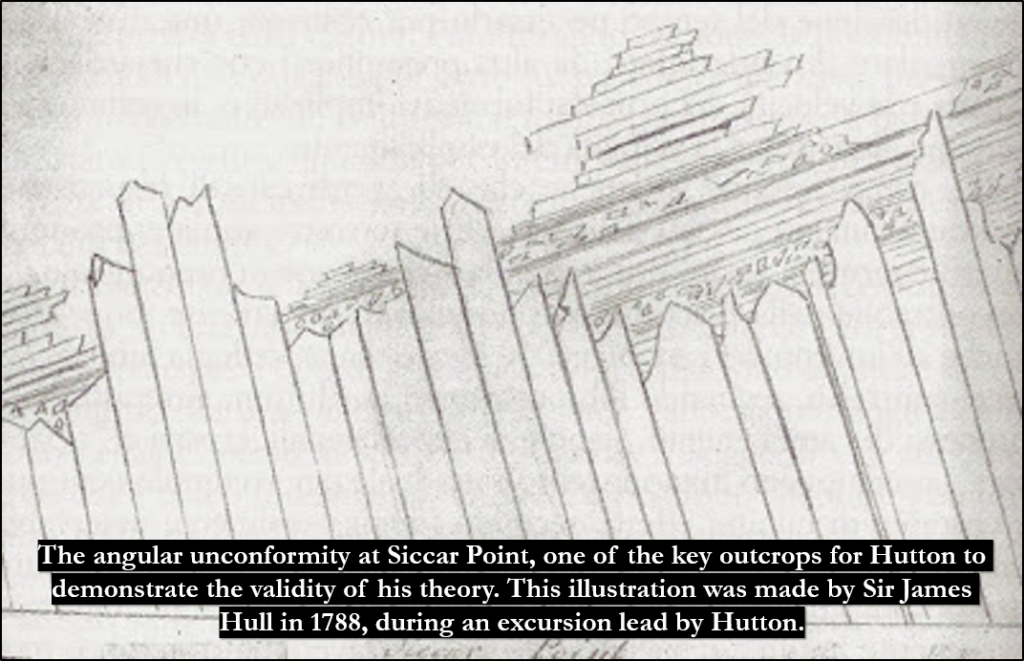
James Hutton, the Heat Engine Driving the Planet and the Leith Glassmakers
Leith in its time was a major centre of Scottish industry. One of the large businesses was glass blowing. They used to make glass with sand. James Hutton took notice.
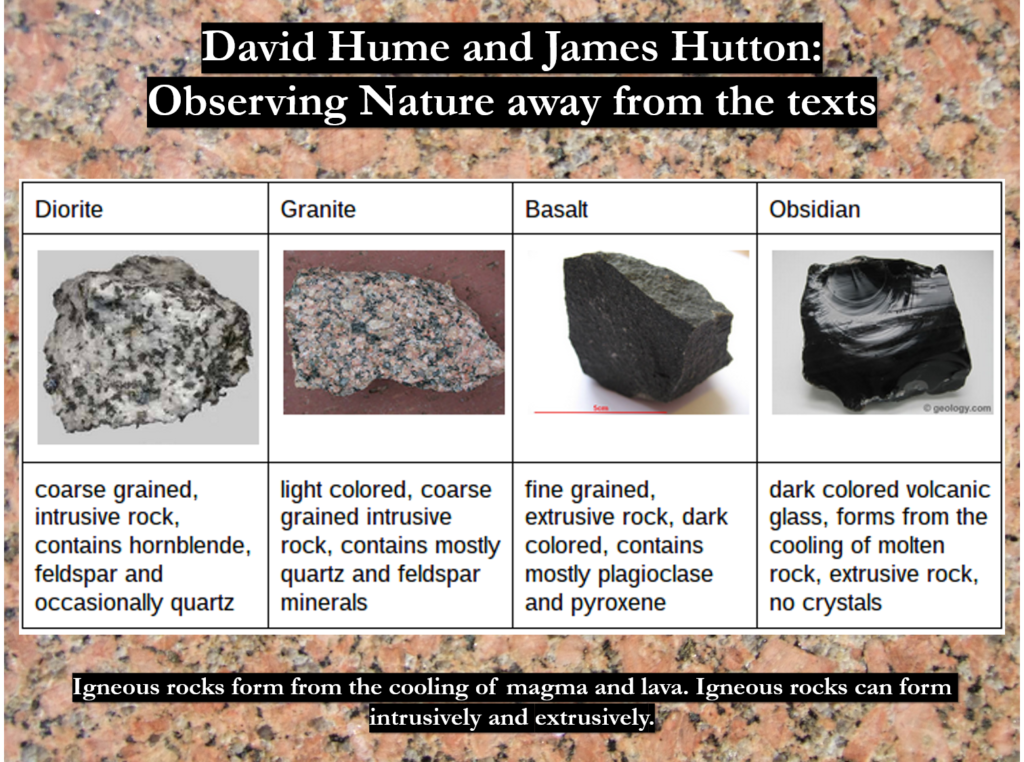
James Hutton did something very amazing for his time. He tried to find mini examples of the evidence for the large processes, he has observed. He observed how granite, is formed of large crystals that could easily be picked up by the human eye. He also got samples of obsidian from Italy. He was convinced that both material got to the Earth as hot material and cooled down after meeting the cold rock of the sediments.
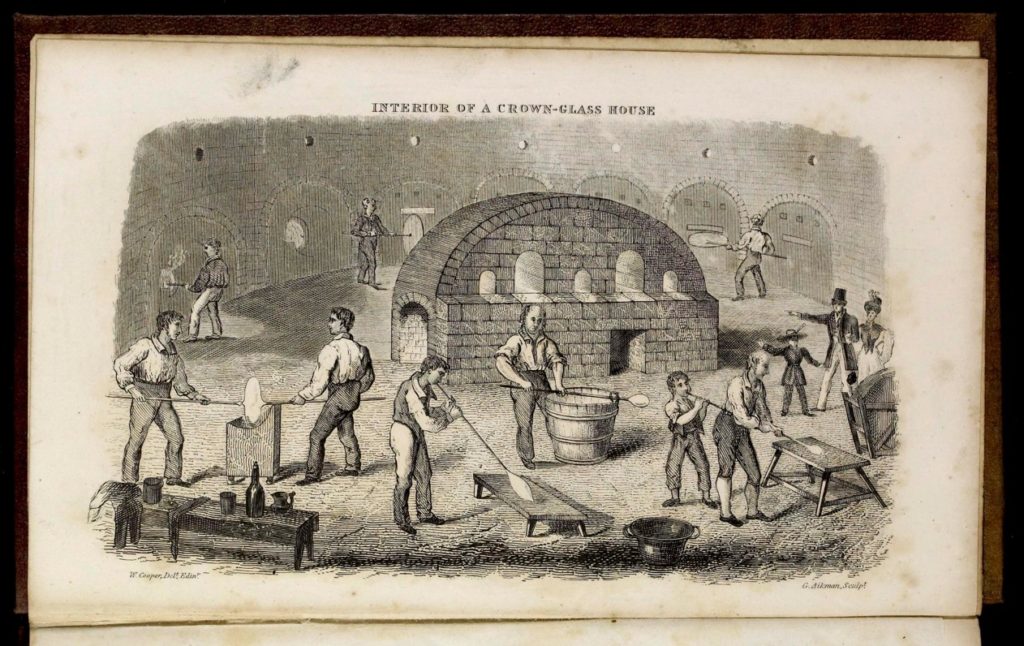
Bellow glass making can be seen. Hutton compared how glass cooled to how lava cooled in the real world. He realized that how fast things cool, that is universal. So volcanic glass happened the same way as human glass. And when glass cools slowly, it forms the same crystals as igneous rocks! James Hutton recognized that at Glen Tilt.

“The volcano was not created to scare superstitious minds and plunge them into fits of piety and devotion. It should be seen as the vent of a furnace.” – JAMES HUTTON (1788)
Charles Lyell and Charles Darwin
Charles Lyell gives a scientific basis for geology, he set up a method based on change through time. He highlighted that Earth wasn’t fixed, it was in an up and down motion. Lyell was born in Angus, his work included the expansion on Hutton’s work and the creation of geology as a serious science based on field evidence. Lyell traveled all over Europe and all over North America.
He was a mentor to Charles Darwin as Charles started out as a geologist from the University of Edinburgh before transferring to Cambridge. He took the work of Charles Lyell with him when he went on his journey around the globe with the ship, Beagle.
Lyell’s work inspired Darwin on evolution.
“But Geology carries the day: it is like the pleasure of gambling, speculating, on first arriving, what the rocks may be; I often mentally cry out 3 to 1 Tertiary against primitive; but the latter have hitherto won all the bets.” – Charles Darwin
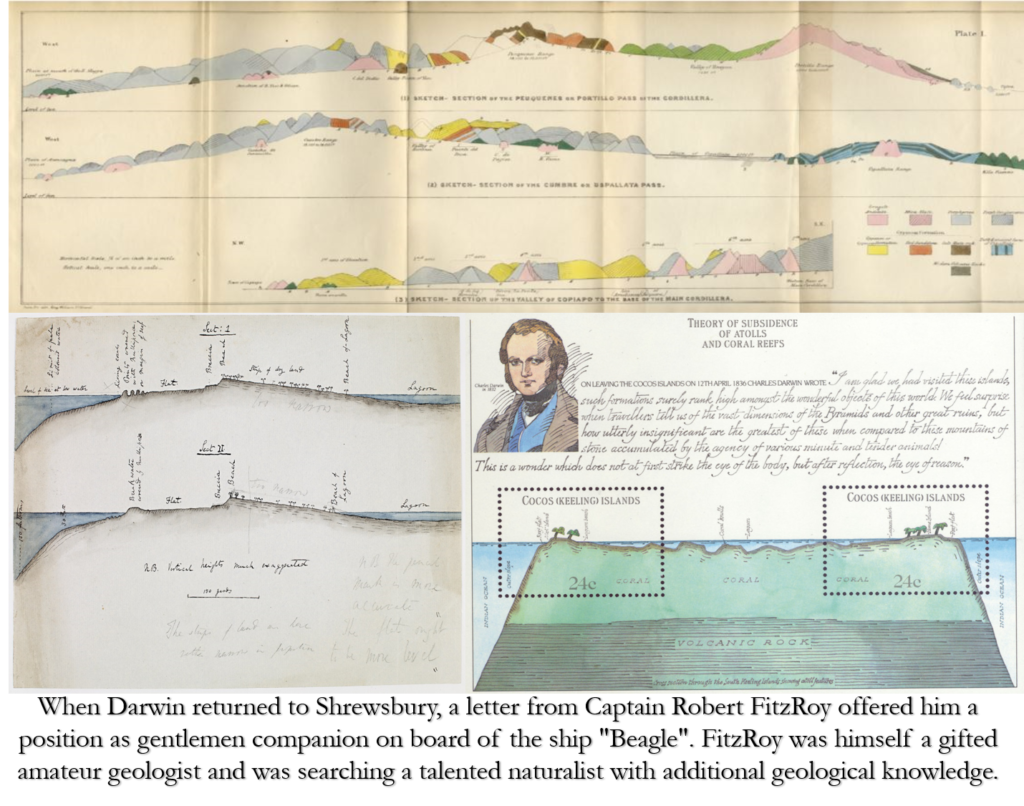
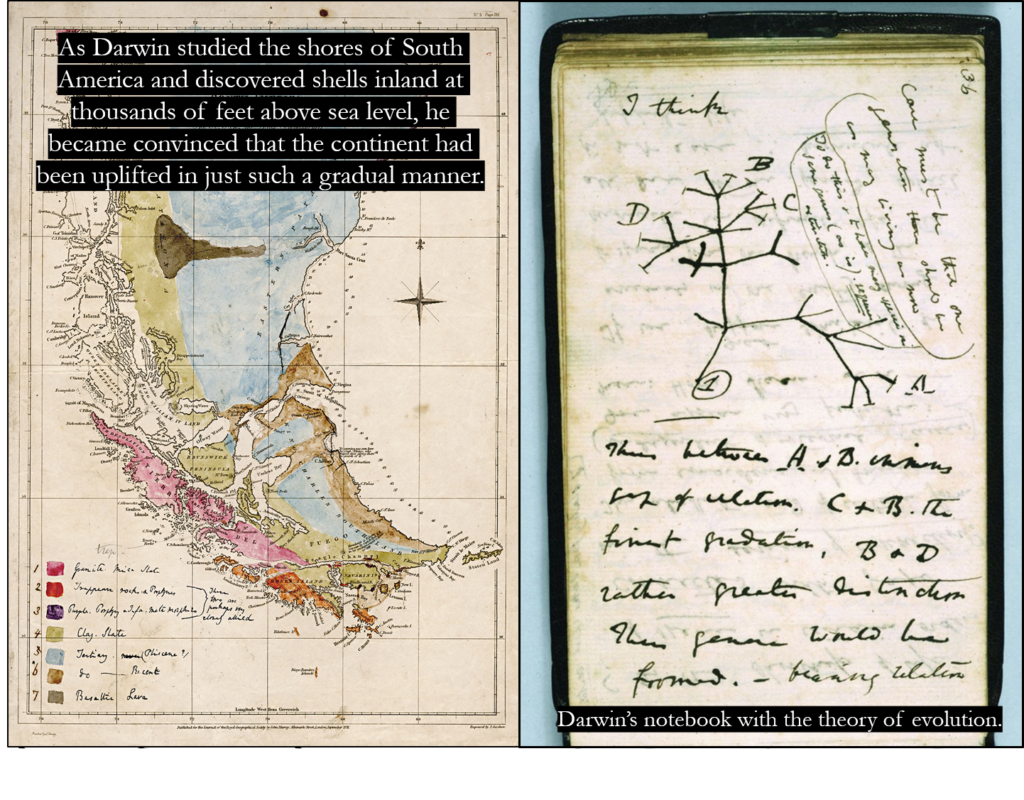
Darwin is a very inspiring character:
Adam Sedgwick and Geological Time
Adam Sedgwick divided up the geological timescales into Devonian and Silurian. He along with Charles Lyell traveled around Europe and studied the volcanoes of Italy.
Poems
Inspecting a Puzzle of an Ore under a Petrological Microscope
Inspiration
This was inspired by my Ores and Mining Course. We used the Ores petrological microscopes to study the different types of ores. There is a nice aspect of geology, where the grey rocks can be sliced open into thin slides, through which light is projected through the minerals. This creates a great range of colours and patterns. There is some artistry in science!
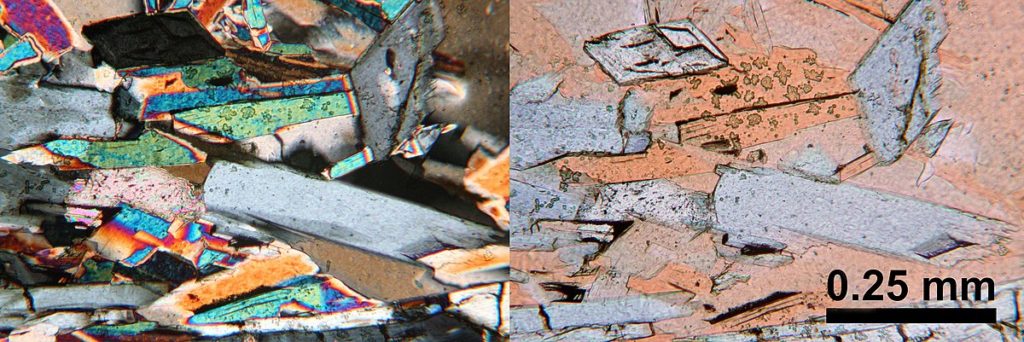
Amphibole fragments in mica groundmass in a thin sample from Siilinjärvi apatite ore. Photomicrograph in cross and plane polarised light.
Inspecting a Puzzle of an Ore under a Petrological Microscope
Inspecting a Puzzle of an Ore under a Petrological Microscope
There are many ways to travel around the world,
Seeing many words, worlds, different weather.
There are many ways to go back in time,
You just need a telescope, look up in the sky, the starlight of today was emitted 1000s of years ago!
But there is only one way to travel back in time, and travel the world as well, the Ores-
Petrological microscope.
The Petrological microscope is a strange creature,
Made of multiple stages,
Pulls light sources, and a multitude of lenses,
The stage can be rotated around,
Scattering spectra in all directions.
The microscope opens little worlds!
Slides of rock cut down to 0.003 mm,
Put through the probing light of the eye,
The rock sparkles in a multitude of colours.
Little worlds trapped in stone.
The ores show their true beauty under the direct light as well,
They are gold, creamy with milky, or a tad bit brown,
Chalcopyrite veins cutting the earlier sphalerite,
Hematite dances with Pyrite,
While the Pentlandite looks on,
Telling us the tales of past ore deposition.
The colours dance as the stage spins around,
Garnets, stay ever so dark,
With Olivines keeping their bright blue colour,
Plagioclase feldspars stripe through the maze,
As carbonites dance in a night club like haze,
Way too many minerals to name!
Unicorns hide in the eye piece!
Song/Video
The 400,000,000-Year Link Between Scotland and Canada – Tom Scott
I decided that from now on, at the end of each blog I shall include a favourite song/video of something geology related that I liked.
This video gives a perspective on the length of geological time by looking at the history of the Great Glen Fault:




Recent comments